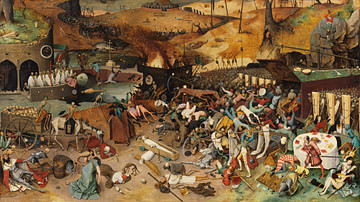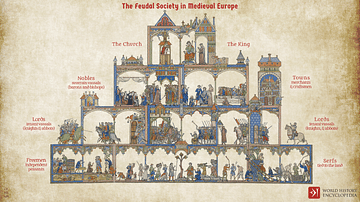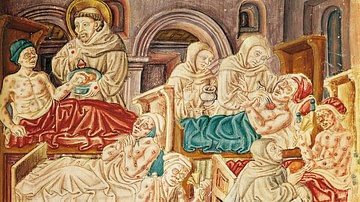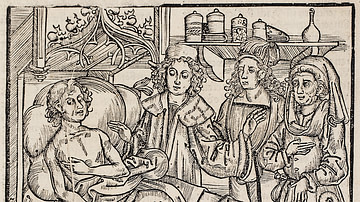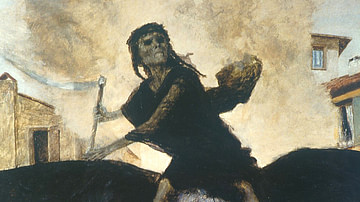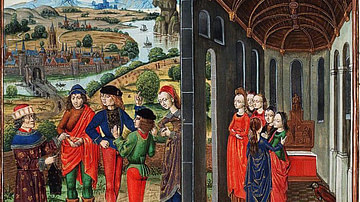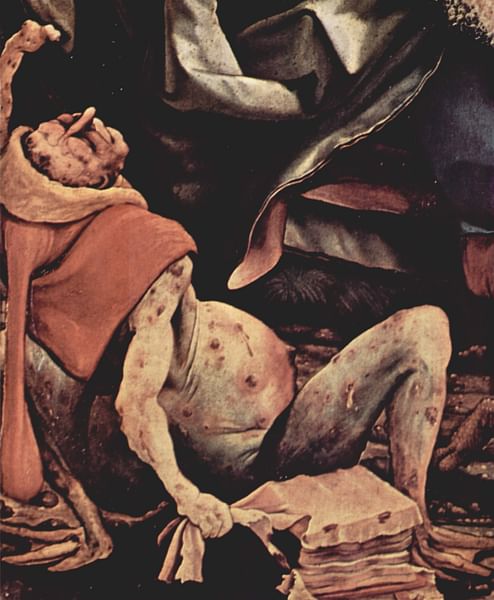
St. Anthony's Fire (SAF) is an illness brought on by the ingestion of fungus-contaminated rye grain causing ergot poisoning (ergotism). The disease's common name derives from the medieval Benedictine monks dedicated to that saint who offered treatment to sufferer's, sometimes using relics of the saint to do so. The 'fire' element is in reference to the burning sensation sufferers of the disease often feel in the extremities of the body. SAF is less well-known than the Black Death plague but was constantly present throughout the Middle Ages. No figures are available to indicate the number of people who may have died from SAF although in one incident alone, an outbreak in France in 994 CE, the illness caused 20,000-40,000 deaths throughout the country. SAF, with its frequent symptoms of gangrene, convulsions, sores and even hallucinations, plagued medieval society, contributing to the oftentimes miserable existence for many people.
St. Anthony (251 - 356 CE)
The founder of Christian monasticism and patron saint of grave diggers, Saint Anthony (aka Anthony the Great) was born to a noble family but at the age of 25 he gave away all of his possessions to the poor following the advice of Saint Mathew. He retreated to a desert area in Egypt along the Nile River, near the mountain Pispir (now Der-el-Memum) where he lived in solitude from 286-305 CE. It is reported that while living the life of a monk he struggled against the Devil while resisting temptation; these stories would later be incorporated into Christian theology.
In honor of St. Anthony's life and struggles, the Order of Hospitallers of St. Anthony was established in 1100 CE at Grenoble, France. There a center was created to care for people who were afflicted with ergotism. The walls of the hospital were painted in red to mimic the burning sensation experienced by those suffering from the illness. The monks wore black robes adorned with a blue cross. Additional hospitals were founded throughout medieval Europe to assist additional sufferers. The primary treatment practiced at the hospitals was to feed the afflicted a diet of grain free of the ergot spore.
The Illness
St. Anthony's Fire, also known as “holy fire” or “internal fire,” was a common illness in the Middle Ages. Waves of outbreaks occurred throughout the period sickening millions and killing tens of thousands of people. The outbreaks were a result of larger quantities of rye grain being grown and increasing numbers of people eating contaminated rye flour. Those who fell ill suffered from poisoning by an ergot fungus, Claviceps purpurea. This particular fungus grew on rye, a major ingredient in making bread. It would not be until 1596 CE that a German physician, Wendelin Thelius, connected the ergot fungus to the rye grain. The fungus, however, was not unknown. In 1582 CE another German doctor, Adam Loncier, described the use of small doses (3 grains) of ergot to produce strong contractions during pregnant women's' labor.
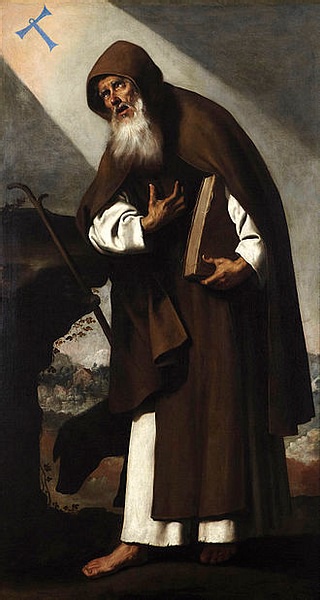
As the oldest recorded plant disease, the earliest mention of ergot dates to 1100 BCE in Chinese writings detailing its use in obstetrics. An Assyrian cuneiform tablet, dated 600 BCE, described pustules on grains. The first documented epidemic of ergot poisoning occurred in the Aquitaine region of France in 944-945. In the first outbreak, nearly 20,000 people became infected and died. A second outbreak, 40 years later, resulted in nearly 40,000 deaths.
Symptoms
Ergotism is an illness caused by moldy rye grain containing the fungi ergotamine. Ergotism exhibits two main characteristics: gangrene (in chronic ergotism) or convulsions (in acute ergotism). The chemical composition of ergot poisoning often causes those affected to appear “crazy.” If left untreated, blood flow to an infected person's extremities is restricted causing burning sensations while in later stages gangrene sets in causing fingers, toes, hands and feet to drop off the body. Hallucinations, agitation, sores, muscle cramps, nausea, insomnia and convulsions are additional symptoms of ergotism. This condition may be the source of “dancing epidemics.” Dancing epidemics (also known as dancing plagues or tarantism) occurred between the 14th and 17th centuries CE. Various medieval chronicles described groups of people engaging in this behavior sometimes for months on end. These dances appeared to be involuntary and were possibly the result of ergot poisoning, vengeful spirits, supernatural fears, the bite of a tarantula or scorpion and the distress of poverty and hardship of everyday life combined with the occurrences of natural disasters. These symptoms, especially at the onset of the poisoning, caused people to confuse the affliction with bubonic plague.
Attitudes & Religion
Many people associated the symptoms and illness as an entry to Hell. To that end, religion and faith played important roles in the early Middle Ages in combatting the sickness. The collapse of the institutions of the Roman Empire in the West allowed the Catholic Church to dominate society, including the practice of medicine. In the Middle Ages, attitudes and approaches to healing the sick became a combination of Christian orthodoxy, superstition and Greek & Roman medical texts.
The Church declared sickness to be a result of sin. Suffering was accepted as a part of life. Cures and treatments often reflected a mix of ignorant notions derived from antiquity, fate and God's plan for humanity. The Greek tradition of maintaining a balance of the four humors - yellow bile, phlegm, black bile, blood - along with dietary choices and the positions of the moon & other celestial bodies influenced most of the diagnoses and treatments. Plants, especially herbs and flowers, offered physicians a cure to treat the afflicted. The medieval Church argued that such an approach reflected God's promise to provide a suitable cure for every affliction.

In terms of hospitals or other institutions for treating sick people, it was Charlemagne (l. 742-814 CE) who required that cathedrals and monasteries build hospitals and schools to teach medicine. Until 1300 CE monasteries provided the bulk of the care for the sick and poor following St. Benedictine's Rules that prioritized the care of the sick above all other activities. It was common to find different saints associated with the hospitals to whom both the patients and monks appealed to in hope for a cure. Various orders of military (Knights Hospitaller) and non-military orders (Order of the Holy Spirit, Order of St. John of God) established hospitals throughout Europe and the broader Mediterranean world to care for soldiers, pilgrims and the poor.
Treatments
It should be of little surprise that in combatting SAF, the Benedictine monks employed the use of relics from St. Anthony to assist those stricken, claiming the relics to be a divine cure. This approach was validated by Guérin la Valloire, a French nobleman, in the 11th century CE who claimed the relics produced a cure for his own affliction. Along with his father, Guérin founded the Hospital Brothers of St. Anthony in 1095 CE to deal specifically with people afflicted by ergotism. By the end of the 15th century CE nearly 400 hospitals were established by the Brothers throughout Europe. Treatments included lard-based topical ointments, referred to as St. Anthony's water, medicinal plants and St. Anthony's wine (made from grapes near Vienne where the relics were stored). The wine was thought to possess miraculous healing properties. In the 15th & 16th centuries CE, the illness appeared throughout Germany, Italy and Flanders where affected people danced uncontrollably. Known as St. Anthony's dance, the illness was associated with demons and the Devil. St. Anthony's Fire diminished throughout the European population when wheat began to replace rye as the primary grain in people's diets.
In the modern world, ergotism is a rare event. Historians have debated the role of ergotism in the symptoms exhibited by the young girls (hallucinations, burning and prickly sensations) which led to the accusations and subsequent trials & executions during the Salem Witch Trials (1692-1693 CE) in colonial America. By the early 1800s CE preventive measures were implemented to combat and prevent ergotism: planting clean seed; promoting standard practices in planting and harvesting techniques; appropriate crop rotation; and proper fertilization of the seed during the growing period. Despite the deadliness of ergotism, ergot was used for assisting in inducing labor during difficult pregnancies (until safer drugs were developed) and combatting migraine headaches. Contemporary medical science has also been exploring the use of ergot for treating dementia and Parkinson's disease.
Cultural Representations
The prevalence of St. Anthony's Fire as an illness throughout society prompted medieval artists to include representations of the suffering in their works. Among the more well-known depictions is Martin Schongauer's engraving The Temptation of St. Anthony (1470-75 CE) and Hieronymus Bosch's The Temptation of St. Anthony (1501 CE). Perhaps the best artwork is Matthias Grünewald and Nikolaus of Haguenau's Isenheim Altarpiece created between 1512-1516 CE and located in the Unterlinden Museum in Colmar, France. It is a multi-panel piece created for a hospital chapel at a monastery in Isenheim which treated victims of SAF. Grünewald lived for a period of time with St. Anthony's monastic order. The artist created the altarpiece as a sort of “thank you” gift for the care and lodging he received from the brothers. A renowned piece of Christian art, it features Jesus in the center of the Crucifixion and Resurrection panels while also prominently displaying St. Anthony. The two individuals are meant to represent the ideas of hope and consolation. The overall message of the work expresses the idea that pain can bring the suffering believer closer to God. A closer inspection of the altarpiece reveals that St. Anthony's fingers display a bluish color, often a sign that the sufferer is experiencing a peripheral vascular problem. Speculation suggests that St. Anthony was suffering from Raynaud syndrome, a condition in which external parts of the body, especially fingers and toes, become numb and cold because blood is being restricted to the smaller arteries. In some cases, Raynaud syndrome is also linked to ergotism, the cause of St. Anthony's Fire.

